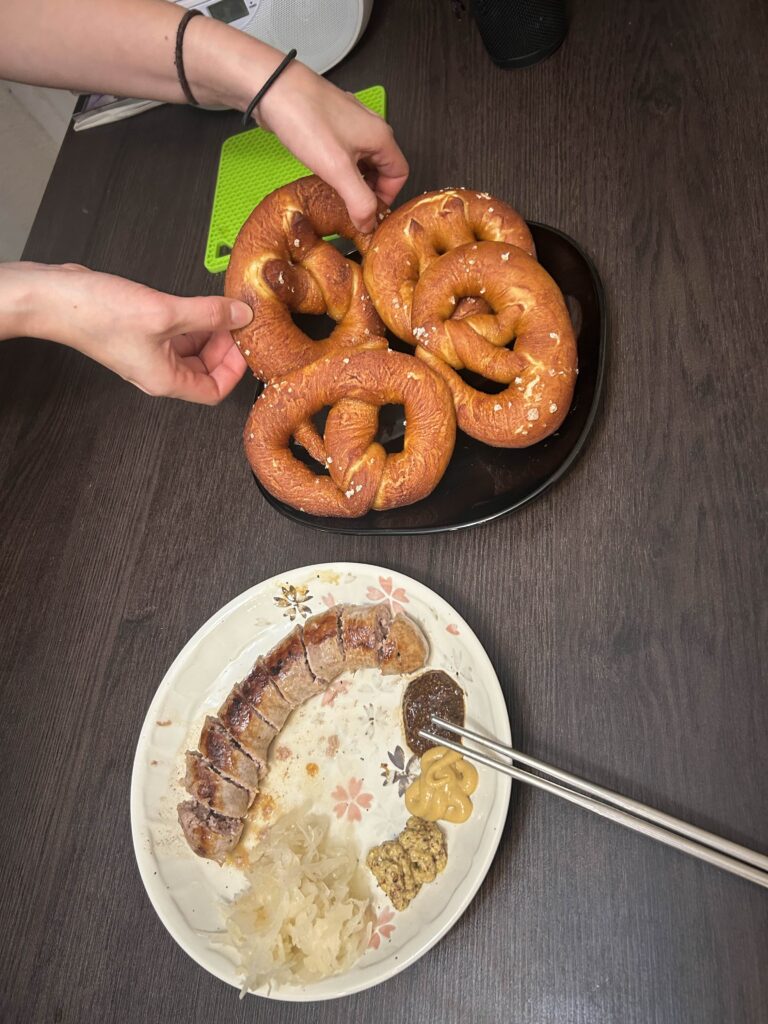My sister married a guy from Munich, and they’re coming up here for Thanksgiving. It’s the first marriage in the generation-tier I belong to, so it’s pretty big. A week or so ago I was at my cousin’s house watching election proceedings (orange man is back) and my aunt knocked on the door. Her house and my cousin’s are on the same lot and she came over to say hello. Aunt said she was planning on baking pretzel buns (laugenbrötchen) for my new brother-in-law but wouldn’t have any oven space on the actual day. She asked me to do it. I said sure.
I don’t know much about German cuisine but I do know that authentic pretzels get their dank amber hue from being dunked in a 4% lye solution before they’re baked. Lye (sodium hydroxide) is a highly caustic alkaline substance that’s used to make soap, clear drains, and decompose road kill. It also causes severe chemical burns if it gets on your skin or eyes. I like Extreme Cooking™ so I made some.

Traditionally, pretzels are made with an enriched dough with low hydration, somewhere in the neighborhood of 50-60 percent. They have about 3-4 percent (baker’s percentage) butter or lard (lard more traditional) cut into the dough. You take that dough and roll it into a long snake-like rope (about the thickness of a corn snake, or maybe a garter snake) lift, twist, and then toss it in the lye bath for 30 seconds.
I decided to ignore tradition and make my laugenbrezel with a 75% hydration dough and no butter. I didn’t have any particular reason for doing that; I just felt like it. However, I learned why pretzels are enriched and why they’re made with lower hydration dough.
First, lower hydration makes the pretzels easier to shape. Due to the dough’s wetness, trying to press it into a long enough rope that it could be twisted into a pretzel that looked like a pretzel and not a dog turd was very difficult. Pretzels have butter in them and less water in the dough so that they’re softer and more pliable, easier to roll out into a long rope and less likely to spring back once shaped.
Second, the richness provided by butter helps give pretzels their softness. Without it, the pretzels were at bagel levels of toothsome.
Finally, I believe that the lower hydration causes them to bake through and internally dry far more quickly when they’re placed in the oven.
I shaped my pretzels more in the Bavarian way because Munich is in Bavaria, but the Swabian style looks a lot more interesting to me. That type has more variation in the pretzel’s thickness and the top is scored.
Anyways, that’s a lot of detail that I’m not sure you’re interested in. The end result was that they were pretty good, but could’ve been better. This is good, though! With enough practice runs, I hope that on Thanksgiving Day my sister’s husband will take a bite of a pretzel I’ve proffered to him and leap out of his chair, exclaiming “Verdammt, dieser Scheiß ist gut!!”
I asked my GF to generate an image of a pretzel man, so here:


Leave a Reply